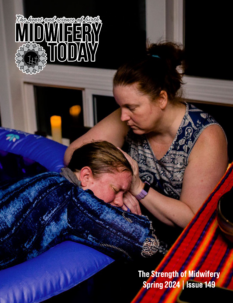
Photo by Bonnie Kittle
Opening the Pelvic Outlet in Labor
Midwifery Today, Issue 144, Winter 2022.
Join Midwifery Today Online Membership
Birth works. We all know that.
Mother’s bodies are generally made to birth their babies. And babies come in all sizes—the same as pelvises. Mostly, the baby and the pelvis fit well together, so during contractions in active labor we see a progressive, smooth, and gentle birth process. Every woman takes time to birth her baby, connecting to her strength, reinforcing her inner power, and learning to dive into her path toward motherhood.
Many times, absolutely no intervention is needed to welcome a baby Earthside. But at times, the second stage of labor baby’s descent can take a long time, and we as midwives start to wonder why and what we could do to help to advance and facilitate baby’s arrival.
The pelvic outlet is the bottom part of the pelvis, and is made up of joints and ligaments. It is the final level of the pelvis. Some call it the hip outlet.
The outlet space can change in size when different positions are used. Often the standard one is not very helpful (opening knees to the sides, and feet go together or stay to the side, too; most common in hospitals in semi declined or supine position on bed)
We must consider two ways of opening the outlet:
- Front to back. The outlet space can be increased front to back based on the movement of the sacrum and coccyx (tailbone). The opening of the pelvic outlet is tied to the outward movement of the sacrum. Therefore, being upright is beneficial to sacrum’s move “out of the way” and not inward, which restricts the outlet size (like when lying on your back in second stage)
- Side to side. The outlet space can be increased side to side with the internal rotation of the femur, causing the ischial tuberosities (sitz bones) to move farther apart.
Let’s focus a bit more on the side-to-side opening. How could we open the pelvis from side to side? Just get knees in and ankles out!
Internal rotation of the femur opens the ischium, the bottom of the pelvic opening (the outlet, or where your baby is trying to vacate the premises from).
To accomplish an internal rotation of the femur while in labor seems complicated, but it is not. It can generally be done by having the knees closer together than the ankles. Knees do not have to be touching each other; they just need to be closer than the ankles. The birthing woman should stay in this position for three to six contractions to cause a change in descent for the baby—if she feels comfortable in this position.
This opening isn’t massive, but it helps to give a bit more space to help the baby’s rotation and descent out of the pelvis to start a life Earthside.
This “knees together, ankles out” position can look different in different settings.
- Hands and knees on bed or floor: a typical hand and knees position, just keeping her knees close together and putting her ankles wide out.
- Side-lying on the floor or the bed (ideal for a giving birth with an epidural): get a peanut ball between the ankles and not the knees. Or use some pillows between the ankles and allow the internal rotation of the femur to happen. Some need support of a pillow between knees if having the knees touching is too intense of an internal rotation. In the hospital setting another idea could be useful: lower the bottom portion of the bed to allow the bottom leg to sit in an internal rotation. Place the ankle on the lower portion and the knee on the middle portion of the bed.
- Instead of a peanut ball, you can use a stirrup in the hospital setting. Place the upper leg and just the lower part of the leg into it and use the stirrup into the “knees together-ankles out “ way.
Important:
The internal rotation should be initiated at the hip, not at the knee.
The entire leg is seen as a unit and thigh, with lower leg, should be moved. You can hurt/strain the knee ligaments when only moving the lower leg.






















